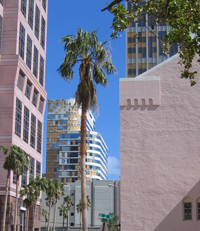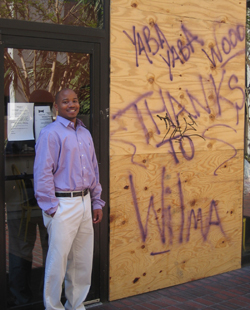Click on image to enlarge. |
Hurricane Wilma battered facades and windows of older office towers in downtown Fort Lauderdale, Fla. Because the storm approached the city from the west and passed to the north, western exposures of the Templeton Building (left rear) and One Financial Plaza (right) suffered some of the heaviest damage. |
After experiencing the busy 2004 hurricane season in South Florida, I thought I was ready for any storm that might blow ashore. Hurricane Wilma proved me wrong.
As a resident of Broward County, which took Wilma’s full force, I am relieved to say that my family and I were not harmed, and our home was spared damage. We had traveled to Orlando for a long-planned weeklong vacation a couple of days before the storm reached South Florida. We monitored developments from the safety of Walt Disney World and figured everything would be back to normal by the time we returned home.
Because we knew Wilma was projected to head to Florida, we took the usual hurricane precautions before we left for our vacation. We put up metal shutters to protect our home from intense winds and flying debris. We also made sure that we had ample supplies of bottled water, canned goods and fresh batteries, even though we would not return for a week. We had these goods on hand because we had stocked up in late August, before Hurricane Katrina crossed Florida en route to her devastating date with the northern Gulf Coast.
So, like many of our neighbors, we thought we were ready when Wilma came to town. But all of our recent experience failed to prepare us for what happened next.
Wilma came ashore near Naples in Southwest Florida as a Category 3 hurricane, with peak winds exceeding 120 mph. Prior to landfall, forecasts projected that the storm would lose intensity as it traveled across the peninsula, weakening to a Category 1 hurricane by the time it reached the east coast. However, Wilma maintained much of her strength and was a strong Category 2 hurricane with top winds near 100 mph when she made her way to Miami-Dade, Broward and Palm Beach counties.
Wilma left more than 3.2 million homes and businesses without power. For some residents, this outage lasted for as long as three weeks. It took 12 days before power was restored to my home. In 2004, when four hurricanes struck Florida, our longest power outage was three days.
After Florida Power & Light Co., the state’s largest utility, announced that it would take weeks to restore power in many areas, we and many other families purchased gasoline-powered generators to provide some electricity to our homes. With the generator, we were able to run appliances such as refrigerators, fans, televisions and DVD players, which allowed us to regain some semblance of normalcy. The generator’s loud humming, however, made it seem as though we were at a construction site instead of in our home. Life away from home was not much better. Though most gas stations had fuel, many were useless because they did not have electricity to operate the pumps. This created long lines at stations in areas with power as many motorists waited up to six hours to fill their tanks in the first few days following the storm. At that time, we began to see long lines at the stations near Disney World, and we heard many stories of people driving to Central Florida to get gas and to shop for food and other supplies unavailable back home. The situation improved by the end of the week as FP&L restored power to more of South Florida’s commercial areas.
Traffic was another nightmare. The few signals that Wilma did not blow away were out of service for lack of power. As a result, a commute that would normally take 20 minutes became 40 minutes to an hour. In an attempt to get around the gridlock on local streets, many motorists packed the expressways, which provided little refuge.
FEMA Provides Assistance
Most of my neighbors did not return to work until a week after the storm. As a result, they lost wages while having to deal with the expense of replacing the food in their refrigerators that spoiled after the power went out. This happened in rich and poor neighborhoods across South Florida. Fortunately, people who needed help did receive some financial assistance from the Federal Emergency Management Agency, which implemented a temporary food stamp program for hurricane victims in South Florida. FEMA also reimbursed many people up to $830 for the cost of purchasing generators while they were without power.
Public schools in the Broward County district did not reopen until Nov. 7, exactly two weeks after the storm. This presented a problem for parents with children in elementary school or day care. How were parents supposed to return to work without having a place to send their children? We were fortunate to be on vacation during the first week after Wilma because our daughter’s babysitter was out of town and did not return until the following week. Otherwise, we would have faced the same dilemma as many other parents.
Click on image to enlarge. |
| Shomari Hearn stands beside a reminder of Wilma’s visit to downtown Fort Lauderdale, Fla. |
Although the final numbers are not in, current estimates are that the property damage from Wilma will be in the range of $6 billion to $10 billion in South Florida. As is typical during major hurricanes, mobile homes in the path of the storm and its tornadoes were demolished. Many homes suffered roof damage, evidenced by the blue tarps that continue to cover the tops of many residences. Trees were blown on top of cars, houses and power lines. In my development, heavy winds ripped a metal shutter from one neighbor’s home and blew it into the side of another neighbor’s car, which is ironic, considering that the shutters were meant to mitigate property damage, not create it.
Some of the tall office buildings in downtown Fort Lauderdale, such as the Broward Financial Centre constructed in 1985, suffered serious damage to their facades. Many of the windows that were blown out have been temporarily fitted with large sheets of plywood until the glass can be replaced. However, the damage sustained by many homes and high-rise buildings in South Florida would have been much worse had it not been for more stringent building codes enforced as a result of Hurricane Andrew.
Andrew hit Homestead, Florida City and parts of Miami in 1992, causing about $30 billion in damage and leaving more than 250,000 people homeless. Andrew exposed the subpar materials and shoddy construction practices used to build homes in South Florida for years. The Florida Building Commission adopted the Florida Building Code in 2002 to provide guidelines for engineering homes and buildings to withstand hurricane-force winds in the range of 130 to 150 mph.
From the looks of many residential high-rise buildings in downtown Fort Lauderdale built in the last three years, the new building codes were a success. There was no structural damage to any of the buildings, some of which soar as high as 35 stories, and very few windows were blown out. The hurricane-resistant windows did their job as advertised, which is all the more impressive because at higher elevations wind gusts are more intense. More than likely, the higher floors of these buildings were experiencing Category 3 hurricane winds while Wilma only measured Category 2 closer to ground level. Some tenants of the newly constructed buildings reported water damage, but that mostly resulted from leaky seals around the windows rather than failure of the window glass itself.
Although the commission did not adopt the more stringent building code until 2002, many developers started constructing more hurricane-resistant structures soon after Andrew. As a result, most of the major damage from Wilma appears to have been inflicted on homes and buildings constructed before Andrew. The Florida Building Commission is currently studying that damage to make further improvements to the code. If Wilma had approached Florida from the east, it would have been a different kind of hurricane entirely. The tri-county area would likely have experienced very large storm surge, which would have inflicted much more damage, created a lot more flooding and claimed many more lives than actually did occur along the east coast.
Storm surge is ocean water that is pushed ashore by a hurricane’s winds. The size of a surge depends on multiple factors: wind strength, air pressure, the size of a storm’s eye, the distance hurricane-force winds extend from the storm’s center and the speed at which it comes ashore. The damage and flooding from Hurricane Katrina are good examples of what can occur as a result of high storm surge and a shallow continental shelf. In Biloxi, Miss., which was devastated by Katrina, there were reports of a 30- foot storm surge.
Lessons From Hurricanes Wilma, Katrina And Rita
The 2005 hurricane season has taught me:
- There is no such thing as a “safe” hurricane. Katrina was only a Category 1 storm when it first made landfall in Broward and Miami-Dade counties, but it still killed 11 people and caused substantial flooding in Florida before it intensified in the Gulf. Wilma was only projected to be a weak and less-threatening hurricane by the time it hit the east coast, but was much more intense and created a lot more damage than anticipated.
- Evacuate if an intense hurricane is headed your way, especially if you are projected to be in the path of the right front quadrant of the storm, which tends to inflict the most damage. Katrina showed us that if you have the opportunity and resources to evacuate, you should do so. My evacuation destination will be Atlanta, because it is far enough north of Florida and the Gulf Coast and inland from both the Atlantic and Gulf shorelines.
- Leave before the government mandates an evacuation of your area. Hurricane Rita showed us that if you wait until you are forced to evacuate, it might be too late to leave before the storm arrives. More often than not, this will mean that you evacuate unnecessarily, but it is better to be safe than sorry.
- If you leave, pack all of your important documents (wills and other estate-planning documents, property deeds, Social Security cards, birth certificates, tax information for current year and previous three years).
- Be mentally prepared to live with the effects of the hurricane long after it is gone. My family did not have electricity for about two weeks after Wilma struck South Florida, which I would not ever have imagined, based on my previous hurricane experiences.
- Be careful when operating a generator. After Hurricane Wilma, there were numerous reports of generator related injuries. A man in Davie, Fla., suffered first- and second-degree burns when trying to refuel his generator while it was running.
According to the National Oceanic and Atmospheric Administration, the Atlantic Basin is in the active phase of a hurricane cycle that began in 1995 and that may continue for another 10 to 20 years. Thanks to my experience with Hurricane Wilma, I will be better prepared for the next big storm that comes to South Florida.













